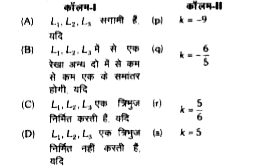का कोणांक होगा : (a) (b) (c) (d)
The correct Answer is:A
Step by step video, text & image solution for ((1-i)/(1+i)) का कोणांक होगा : (a) -pi//2 (b) pi//2 (c) pi//4 (d) pi//6 by Maths experts to help you in doubts & scoring excellent marks in Class 12 exams.
Updated on:21/07/2023Topper's Solved these Questions
- सम्मिश्र संख्यायेंBook:ERRORLESS HINDIChapter:सम्मिश्र संख्यायेंExercise:Jee Advanced (More than one correct Answers)
Explore 23 Videos
- सम्मिश्र संख्यायेंBook:ERRORLESS HINDIChapter:सम्मिश्र संख्यायेंExercise:Jee Advanced (Reasoning)
Explore 6 Videos
- सम्मिश्र संख्यायेंBook:ERRORLESS HINDIChapter:सम्मिश्र संख्यायेंExercise:Solved Multiple Choice Questions (डी मोयवर प्रमेय तथा इकाई के मूल )
Explore 59 Videos
- समुच्चय सिद्धान्त तथा सम्बन्ध Book:ERRORLESS HINDIChapter:समुच्चय सिद्धान्त तथा सम्बन्ध Exercise:JEE Advanced (Reasoning type questions)
Explore 3 Videos
- सरल रेखा Book:ERRORLESS HINDIChapter:सरल रेखा Exercise:JEE ADVANCE (Matrix Match type questions)
Explore 4 Videos
Similar Questions
माना z1 तथा z2 दो सम्मिश्र संख्याएँ इस प्रकार है कि z1≠z2 तथा |z1|=|z2| . यदि z1 धनात्मक वास्तविक भाग तथा z2 ऋणात्मक काल्पनिक भाग है, तब z1+z2z1−z2 होगा
View Solutionकथन-1: यदि n एक विषम पूर्णांक 3 से बडा है लेकिन 3 का गुणज नहीं है, तब (x+1)n−xn−1,x3+x2+x से विभाज्य है।
कथन-2: यदि n एक विषम पूर्णांक 3 से बड़ा है लेकिन 3 का गुणज नहीं है हम लेते हैं 1+ωn+ω2n=3
View Solution(cosθ+isinθ)4(sinθ+icosθ)5=
View Solutionमाना R वास्तविक संख्याओं का समुच्चय है
कथन-1 : A={(x,y)∈R×R:y−x एक पूर्णांक है} R पर एक तुल्यता संबंध है |
कथन-2 : B={(x,y)∈R×R:x=αy किसी परिमेय संख्या α के लिए} R पर एक तुल्यता संबंध है |
View Solution
View SolutionRange of tan−1(2x1+x2) is (a)[−π4,π4] (b) (−π2,π2) (c)(−π2,π4) (d) [π4,π2]
View SolutionThe principal value of the argument of (1+i) is
A. π
B. π12
C. π4
D. 3π4
View SolutionThe argument of 1−i1+i is-
View SolutionThe amplitude of 1+i√3√3+i is a. π3 b. −π3 c. π6 d. −π6
View Solution[" If "I=(2)/(pi)int_((-pi)/(4))^((pi)/(4))(dx)/((1+e^(sin x)))" then "9I^(2)=--],[[" (A) "(9)/(4),],[" (B) "9],[" (C) "(pi^(2))/(4)],[" (D) "(9 pi^(2))/(4)]]
View SolutionRange of tan−1(2x1+x2) is (a)[−π4,π4] (b) (−π2,π2) (c)(−π2,π4) (d) [π4,π2]
View SolutionRange of the function f(x)=√cos−1(√log4x)−π2+sin−1(1+x24x) is equal to
(A) (0,π2+√π2]
(B) [π2,π2+√π2]
(C) [π6,π4)
(D) {π6}
View SolutionThe amplitude of 1i is equal to
a. 0 b. π2 c. −π2 d. π
View SolutionThe argument of 1−i1+i is
a. −π2 b. π2 c. 3π2 d. 5π2
View SolutionOne of the value of (cos(π)6+isin(π)6)12+(cos(π)6−isin(π)6)12 is
View SolutionOne of the values of ⎛⎜⎝(cos(π)6−isin(π)6)12⎞⎟⎠⎛⎜⎝(cos(π)6+isin(π)6)12⎞⎟⎠ is
View Solution
